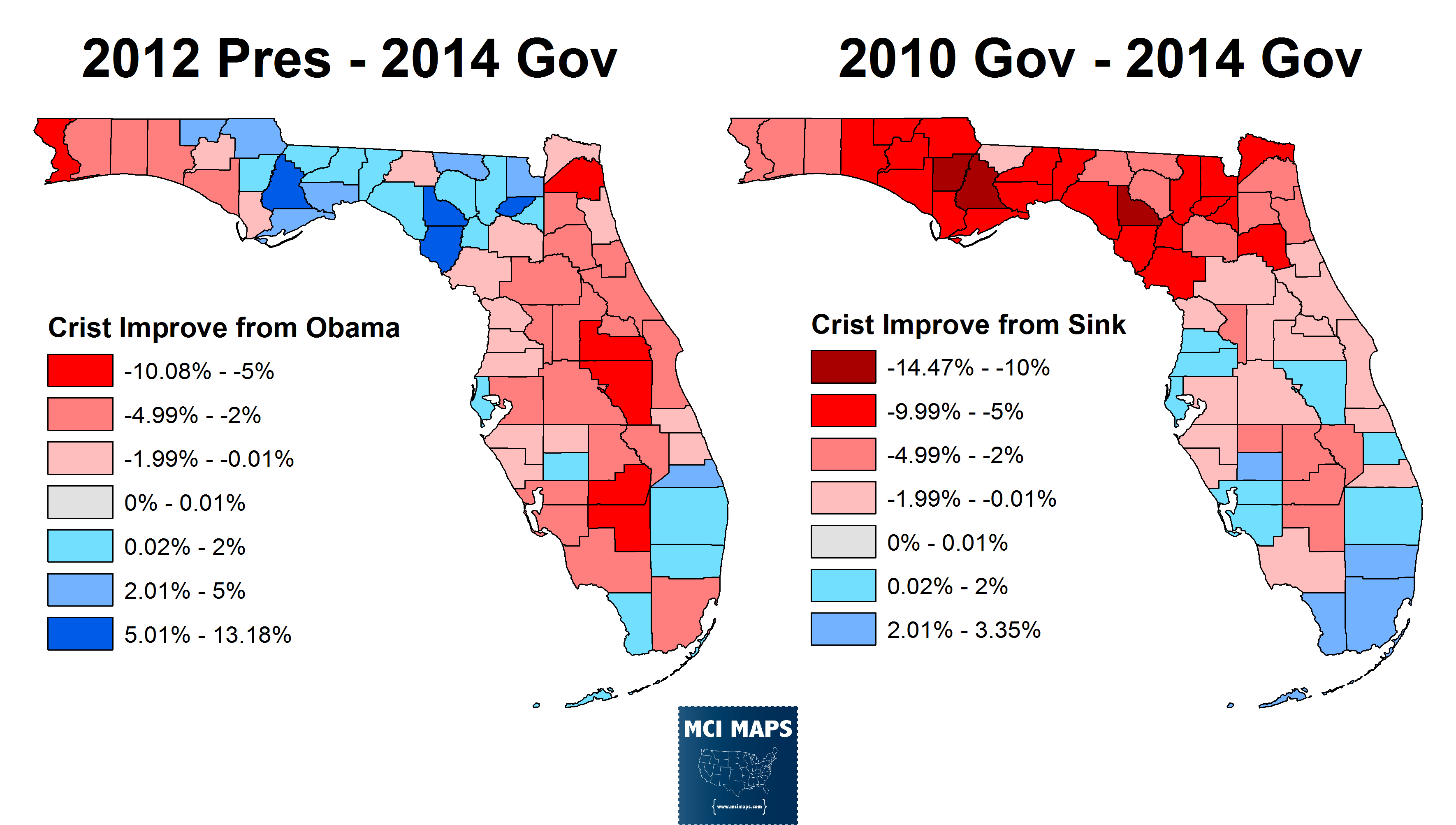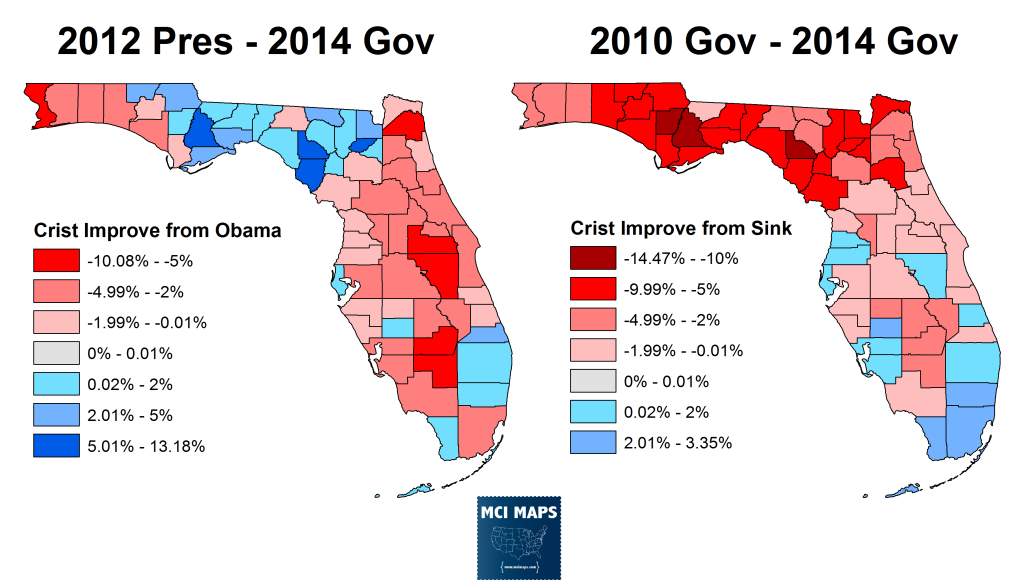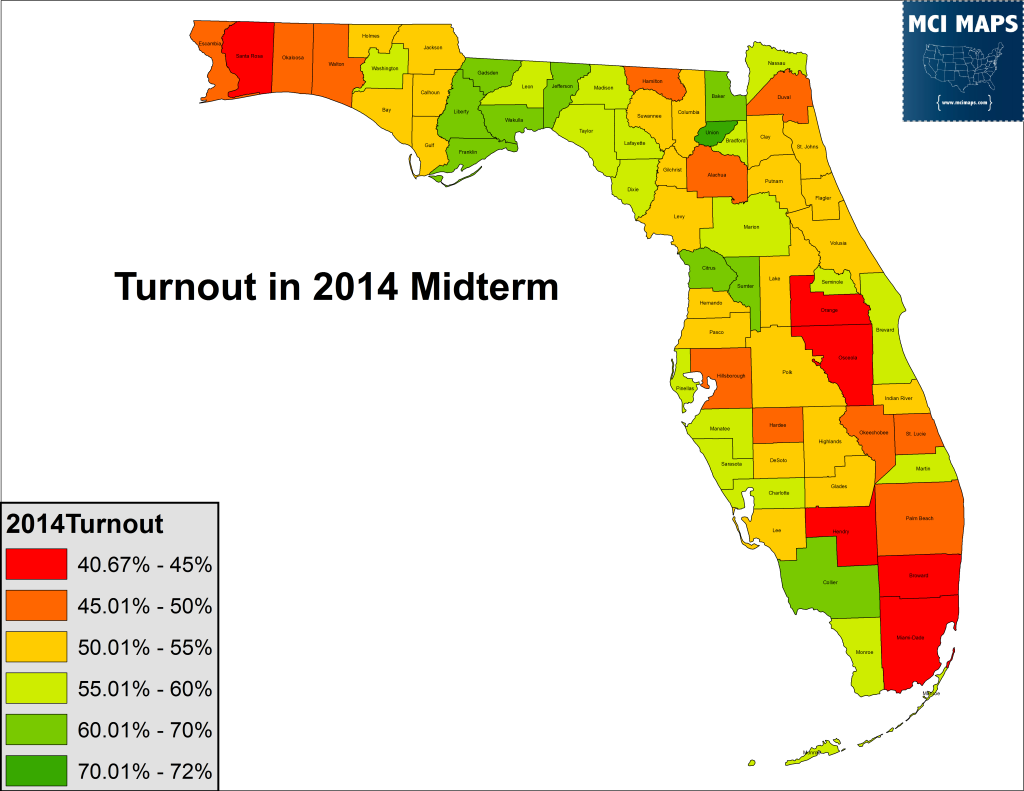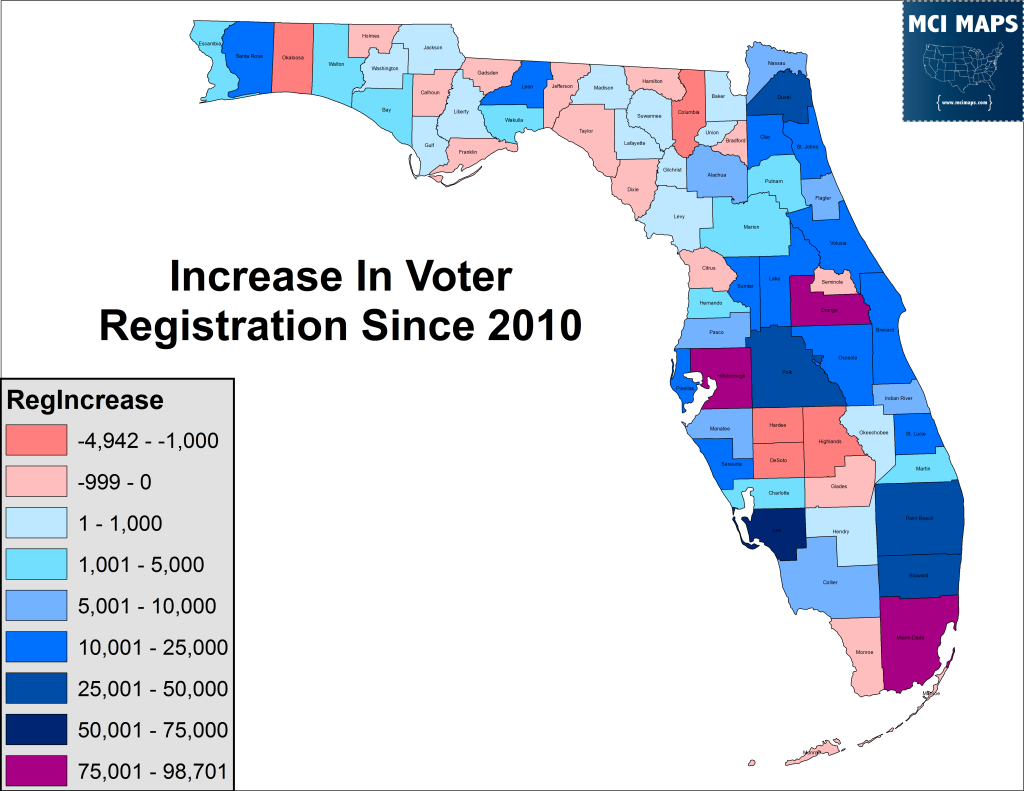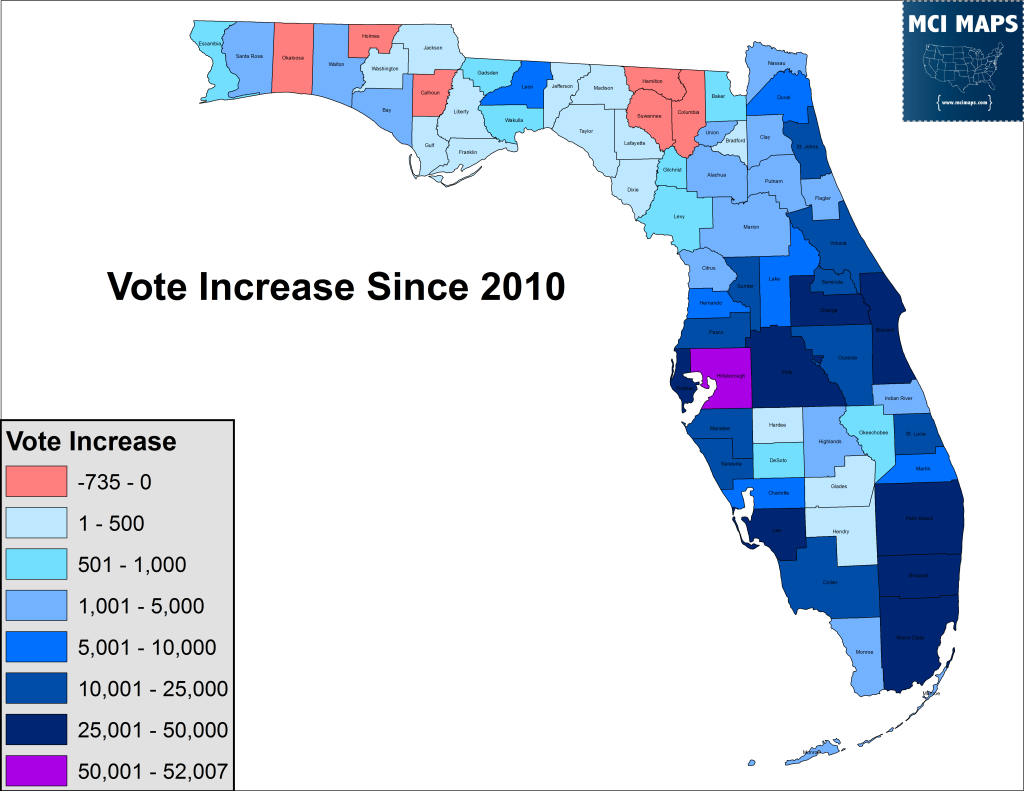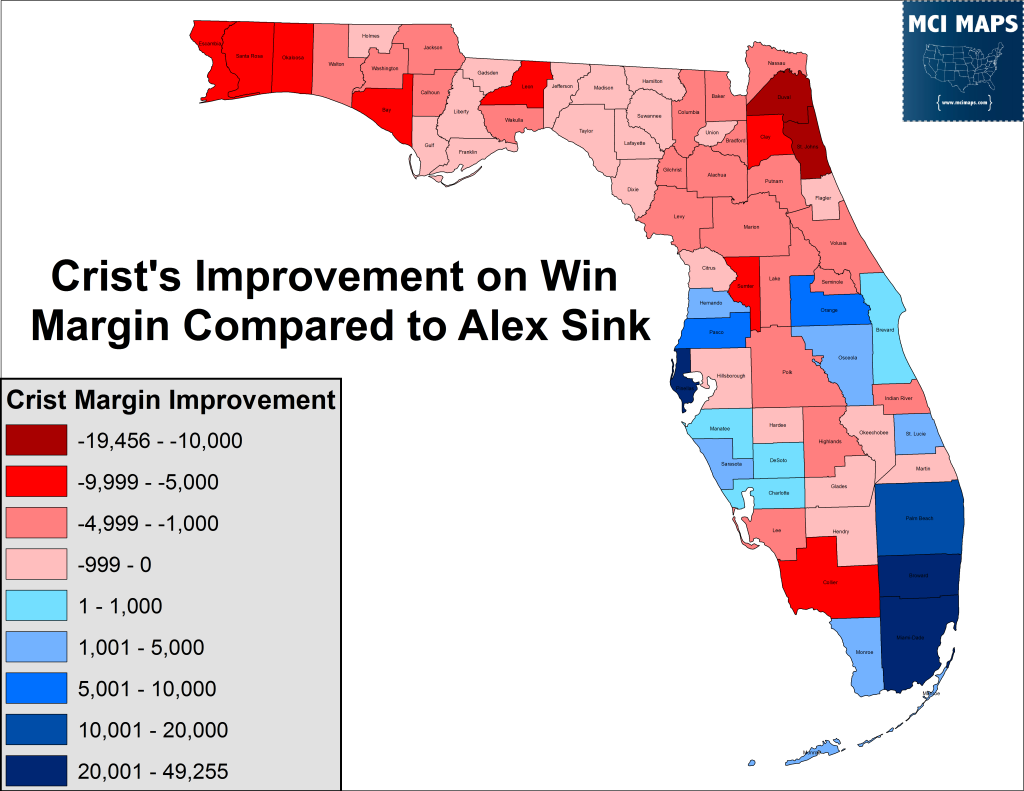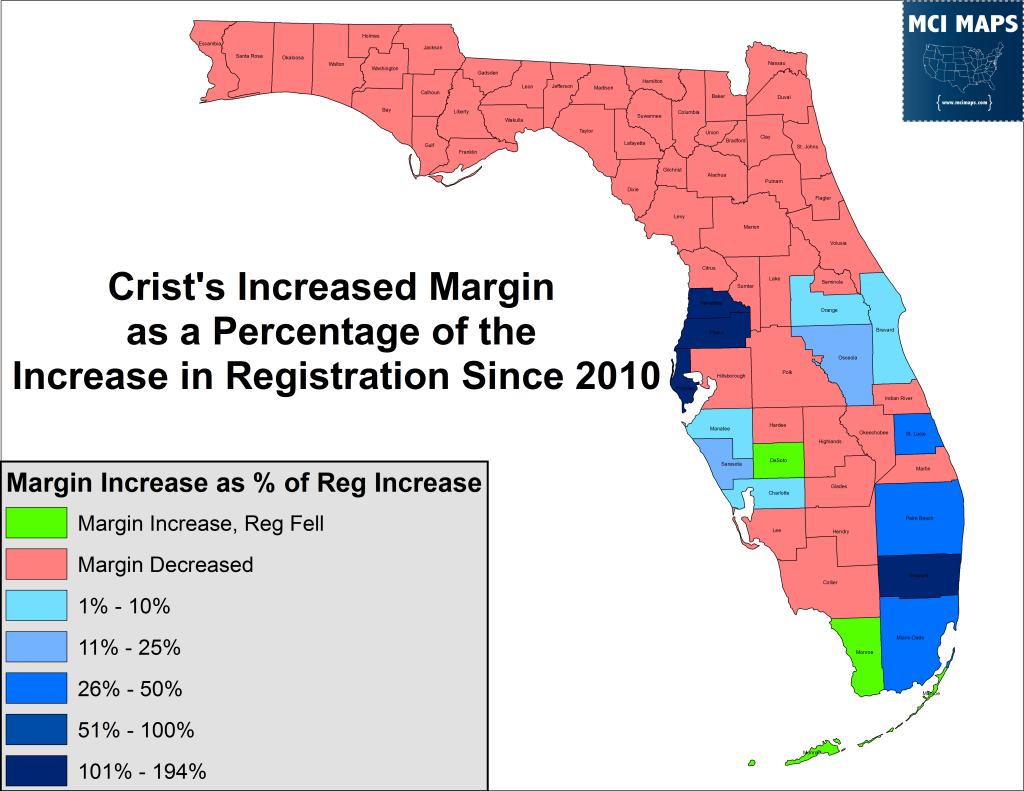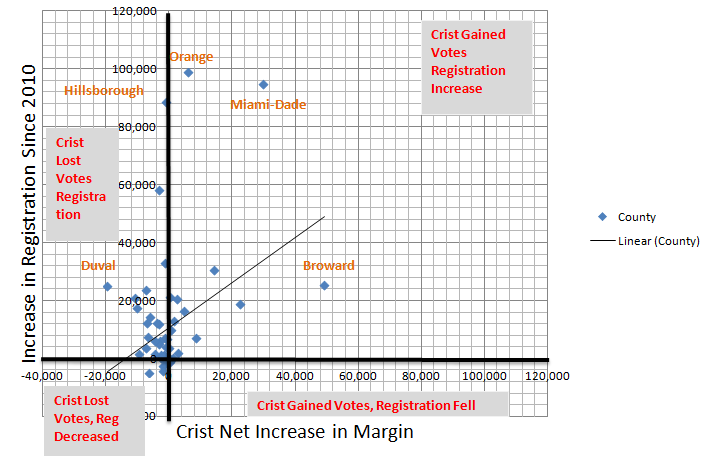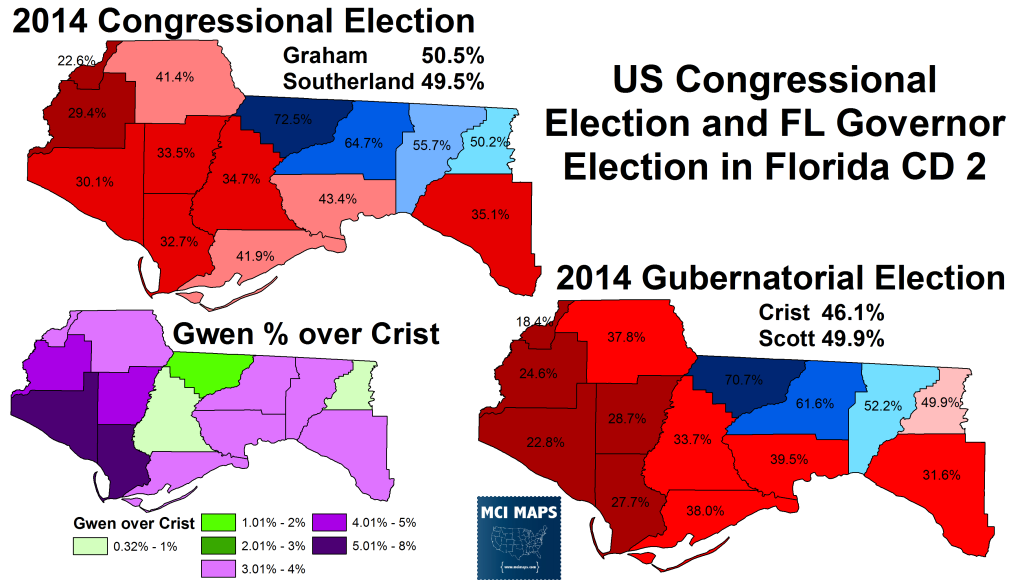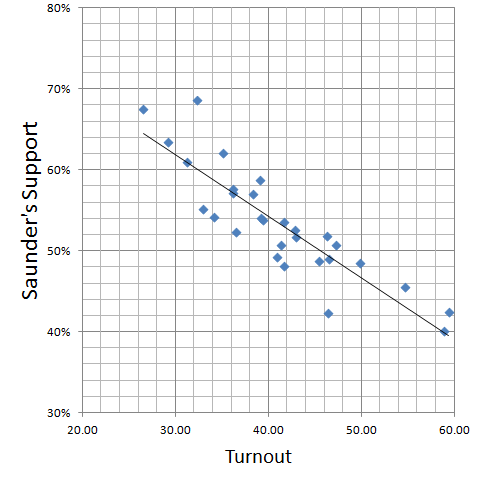A great deal has already been said about the results of the Florida’s Governor’s Race, While Charlie Crist was considered the slight favorite to win leading up to November 4th, Republican Rick Scott managed to eek out a 1% win. I have a great deal to say about this result as well. However, before we get into the postmortem of why Charlie Crist lost, lets take a look at the numbers themselves.
The Numbers of the Loss
Charlie Crist’s goal was simple, close the 62,000 vote gap that Alex Sink had lost by in 2010. However, things did not go as plan. A good deal of blame has fallen on Southeast Florida and its low turnout. However, I feel blame is responsible in other areas as well. Crist lost by around 65,000 votes (numbers may change slightly as the oversees ballots return). Crist ended up over-performing Democrats in key counties, but badly under-performing elsewhere. Below is a map of Crist’s percent of the vote compared to Obama in 2012 and Sink in 2010.
Crist lost ground compared to Obama almost everywhere except part of the southeast (where Scott was very unpopular and Crist invested a great deal of resources), and North Florida, where President Obama has never been popular. However, Crist actually under-performed the President in the western edge of the panhandle, most rural counties in the central part of the state, and especially in the I-4 corridor; with the exception of his home in Pinellas.
Compared to Alex Sink, Crist bled support in North Florida at an alarming rate. I have written about how Democrats have been losing ground in North Florida for over a decade, and Crist’s results furthered that trend. Crist lost ground in most counties, including the I-4 corridor (except Pinellas and Osceola). Crist’s gained ground in the Southeast, which was an important goal. However, the loses elsewhere erased the gains further south.
A good deal of focus of the postmortem has been on turnout. Again, fingers point to low turnout in Southeast Florida. However, this ignores that turnout was down in many parts of the state.
Turnout was indeed low in Southeast Florida. However, it was also low in Democratic Orange and Osceola, as well as scattered Republican rural counties. Democrats, however, did manage to increase turnout in most of their blue counties. The map below show’s increases in turnout since 2010.
Turnout was up in Broward, Palm Beach, Pinellas, Hillsborough, and Osceola. Despite having both Lt. Governor candidates from Miami-Dade, the counties turnout reduced by less than 1%. Turnout was also down in Leon and Orange. Orange is problematic considering it is surrounded by turnout increases. Leon’s fall in turnout speaks to a dramatic failure of the Crist campaign to galvanize state workers behind him. In 2010, Alex Sink got 67% of Leon County, losing only one precinct. In 2014, Crist only got 62% while Democratic Congresswoman-elect Gwen Graham got 65%. Turnout was down in many counties in North Florida, no doubt sparked by voters not liking either candidate.
However, it is a mistake to look at turnout percent increases/decreases in a vacuum. Between 2010 and 2014, many counties saw mass increases in voter registration thanks to the Obama campaign operations of 2012 and Democratic operations in 2014.
Turnout increased by over 90,000 in Miami-Dade and Orange, while other blue counties like Leon, Palm Beach, Osceola, and Broward saw 10,000s of new registrants. In Congressional District 2, the Graham campaign registered over 10,000 new people for 2014. Increases in registration mean higher numbers must show up to keep turnout percentages on par. While many blue counties saw turnout percent decreases, they all saw increases in votes cast.
Only a few counties, all conservative, saw raw votes fall from 2010. The problem wasn’t that Democrats stayed home. Yes if turnout was better in the blue counties Crist could have won. However, he also could have won with the turnout he was given. The problem was he lost support that Sink had in 2010.
The map below shows where Crist netted votes compared to Alex Sink. For example: If a county gave Sink a margin of 12,000 votes and Crist won it by 15,000, then the map below would show Crist’s net as 3,000.
Crist netted large numbers of votes in Southeast Florida. He netted 49,000 in Broward alone, another 29,000 in Maimi-Dade, and 22,000 in Pinellas. Broward and Miami-Dade alone netted him the votes he needed to overcome the Sink deficit. The problem for Crist was he did not net large numbers in Democrat counties like Orange and Osceola. Crist actually lost net votes in Democratic counties like Leon, Alachua, and heavily-populated Hillsborough. Crist netted votes in assorted light Republican counties like Pasco, Hernando and Sarasota, but these were small gains erased by loses elsewhere. Crist lost over 19,000 votes in Duval and another 10,000 in St. Johns. Crist’s decimation in the north further erased gains made further south.
Crist’s gains in Orange and Osceola also mean little considering their massive registration increases. Another way to look at the net vote increases is to see them as a percent of the registration increases.
In Broward, Pinellas, Pasco, and Hernando; Crist’s net gains were higher than the increases in registration. His gains were also modest percentages of the registration increases in Miami-Dade and Palm Beach. In DeSoto and Monroe, Crist netted votes even when registration fell. Crist’s problem was his net increases were a small percent of the registration gains in big population centers like Orange and Osceola. Not only did he not net votes votes in Tampa-based Hillsborough, he lost ground.
In addition to using a map, lets use a scatter-plot to highlight this point. The scatter-plot below shows the increases in registration (top to bottom) and the increases in net votes (right to left).
Broward stands out on the scatterplot, gaining 49,000 votes for Crist after registration increased by just 25,000. Orange and Miami-Dade under performed considering their registration increase. Crist’s biggest problem was many counties fell under the block of registration increases and Crist losing net support compared to Sink.
Why Did this Happen?
So we know what happened. The question is, why did it happen? A great many people have offered their thoughts on why. Some items are true, others are complete nonsense. Always, always vet the author of anyone writing these postmortems. Many have their own personal agenda.
So let me focus on a few key takeaways on what went wrong. First, a shout out to SaintPetersBlog. Peter Schorsch’s postmortem is the closest thing to reality I have read yet. Again, I don’t agree with every point, but I agree with most. Anyway here is where I think things went wrong.
Charlie being Charlie
This is something that has been said by countless papers before and since the loss. Charlie Crist’s insistence on doing things his way was a major problem. It is no secret that Crist-world doesn’t take well to outside opinions and claims that run contradictory to their world view. This was seen when Bill Hyres (the man who got Bill de Blasio elected in NYC) came on to be campaign manager but was gone before it began. Another prominent example was when Eric Conrad was brought on for communications but was gone in a week. In Eric’s case, he went to work for Gwen Graham and craft a message strategy in a seat that went Democratic. Crist has been known to believe his instincts were greater than they were. This manifested itself during the campaign when the Crist campaign would not listen to the Florida Democratic Party when it came to strategy decisions. All those people saying FDP are to blame for Tuesday night either 1) have personal agendas or 2) don’t know the real dynamics that were in play. The Crist campaign did what it wanted to do, and did not listen to calls for more investment outside of Southeast Florida.
Bad Messaging
I am not a messaging expert, but I do have some thoughts here.
Did you know Rick Scott plead the fifth over 70 times? Yeah so does everyone else. The Crist campaign’s focus on Scott’s problems was, in fact, a problem. No, I am no saying they shouldn’t have attacked Scott. However, they acted as if Scott was popular and had to be dragged down. Scott was unpopular when elected, was unpopular when the campaign started, and was unpopular when it ended. The only thing that changed is Crist got unpopular thanks to a wave of negative attacks. The problem for the Crist campaign was it waited to long to go on TV and when it did it didn’t focus enough on his positives. This amazing ad featuring Mike Fasano should have been on TV in the summer and in every media market. However, as SaintPetersblog notes, Fasano was kept away from Crist World for far too long. The campaign had positive ads about Crist, but they were secondary to the attacks on Scott. If Crist had held his popularity higher up, he would be Governor now.
Halfhearted efforts in I-4
In 2010, Alex Sink ignored South Florida and it cost her. In 2014 Crist focused like a laser on South Florida at the expense of everywhere else. The Crist campaign put offices in Orange, Hillsborough, and Pinellas; but every account indicates a lackluster effort in the counties. Major canvassing efforts never came to fruition, offices often with few inside, and a lack of resources for the people there to carry out their goals. This was the same region where 7 state house democrats were being targeted for defeat. While many will claim the Florida Democratic Party dropped the ball, I can tell you they did not. Efforts to get the Crist campaign (which contrary to what people think, was a separate operation from the FDP), to invest more in the Orlando/Seminole region were ignored. The result was Crist under-performing in I-4. Orange county was a major source of problems for Crist. His support was lower than Sink’s and four house democrats lost in Orange/Seminole house seats.
Duval County
The same issues for I-4 apply to Duval County. Crist had offices there, but little else. No major operation existed. Keep in mind this is a county that leans Republican but has an African-American Democratic Mayor, Alvin Brown. However, Brown, foreseeing Crist’s loss, did little to support or help Crist. Crist ended up losing losing Duval by 19,000 more votes than Alex Sink.
All of North Florida
North Florida is dear to my heart at this point in my political life. While I grew up in Broward, my time in Tallahassee and the rural surrounding counties have made North Florida a fascination and focus of mine. That is why it pained me to know that the Crist’s North Florida campaign was drawn on the back of a napkin. The Crist campaign in North Florida was nearly non-existent. This on paper might make sense considering it is a red and sparsely populated area. But it has now been seen what kind of damage can be done. Crist’s losses in North Florida added up to 10s of thousands votes less than Alex Sink got. Crist also knew he had a problem in North Florida from the primaries. Crist did worst in North Florida during his primary against Broward’s liberal state rep, Nan Rich, than anywhere else in the state. This was a sign of conservative democratic distrust of Crist; something I predicted would happen in North Florida in the primary. The voters of North Florida gave Rich support despite not knowing her, they just didn’t trust Charlie. This didn’t mean Crist was doomed in North Florida though. Bill Nelson and Alex Sink both underperformed in the region against token primaries. However, both did much better in North Florida in the general election than Crist did.
The problem was Crist’s decision to forgo major investment in the region. The campaign appointed a North Florida director, Ramon Alexander. Ramon was a major figure in the Southside of Tallahassee, tied to FAMU, and former candidate for county commissioner in Leon. Ramon’s ties to FAMU and the African-American churches in Leon and Gadsden indicated the campaign’s main focus was the African-American community. However, the north Florida operation had little resources. Meanwhile, rural whites, a vast majority of the voting block, were ignored. The campaign did not hire a Leon director and open a Tallahassee office until weeks before the election and invested little resources in it. Efforts into Pensacola were underfunded or non-existent, and those appointed to the area had little experience. None of this was smart. The Crist campaign should have invested in North Florida early on. A director should have been tasked with organizing efforts county-by-county to persuade voters (via canvassing and phone banking) that Crist’s party switch was because the GOP had become to extreme and that he was still the Governor they had supported and liked from 2007-2011. The North Florida campaign should have had an African-American focus and a rural white focus. I don’t blame the people put in charge of the North Florida operation. They had no money or real investment to work with. However, the under-performance is clear. Just look at the Crist support compared to the Gwen Graham support in Congressional District 2.
The same day that Crist lost Congressional District 2, Gwen Graham beat incumbent Steve Southerland to take the seat in congress. The two campaigns stand as the ultimate example of good versus bad campaigns. The Gwen Graham victory is the talk of the political world right now. A Democrat won in a Republican district in a Republican wave year. The Graham victory is thanks to its disciplined messaging and a field organization that ran like a well oil machine. Graham overperformed Crist in every county in the district. Most notable is that Graham overperformed Crist by 7% in Bay County, the home of Graham’s opponent. It is further notable when considering that based past performances, Democrats running for federal office in most of the counties in CD2 under-perform compared to their state-level Democratic allies. Below I list the counties of CD2 that on average give federal democrats less support and how many percentages they on average lose simply by being federal candidates.
| Calhoun | -2.77% |
| Franklin | -3.84% |
| Gulf | -0.34% |
| Holmes | -4.46% |
| Jackson | -2.37% |
| Jefferson | -2.15% |
| Liberty | -5.60% |
| Madison | -0.07% |
| Taylor | -1.81% |
| Wakulla | -4.51% |
The main reason Democrats running for federal offices loses this support is because these rural voters do not want to send a Democrat to Washington. However, in 2014, they were more willing to send Gwen Graham to Washington than they were to send Crist to Tallahassee.
Lack of Coordinated Campaign
Crist may have won if a few things had gone different, but he failed the party that welcomed him with open arms. The campaign did little to help the state house democrats fighting for their lives in the I-4 corridor. Instead, the George Sheldon field operations and data targeting did what it could to aid both the Attorney General candidate AND the state lawmakers who were fighting for re-election by focusing on those vulnerable districts. The Crist campaign did nothing to help vulnerable members by ramping up field operations in these lean-Democratic and swing seats. The effects of this lack of investment were felt the most in District 49, where Democrat Joe Saunders lost re-election. This was the most Democratic seat (59% Obama) to fall to Republicans. However, the mistake was thinking this district was not in play. The district’s heart if the University of Central Florida. In addition, it is 30% Hispanic. Students and Hispanics, two Democratic constituencies less likely to vote in midterms. While Obama got 59%, Crist fell all the way to 52.8% in the district, and Saunders lost by just a few hundred votes. The loss is partly thanks to the wave year. However, turnout, thanks in part to lack of focus by the Crist campaign, was another factor. Turnout was only 40% in the district, and the precincts that supported Saunders the most had lower turnout.
I have zero idea what the Saunders campaign did or planned for, so it is unfair of me to make assumptions about the campaign’s operations. What I do know is that the campaign that would have been the most well equipped to increase turnout would have been the Gubernatorial Operation. However, as I have stated, the Crist efforts in I-4 were weak at best. Saunder’s paid the price for the top of the ticket of his party dropping the ball in Orange County.
Conclusions
A great deal more could be said about what happened with the Crist campaign. This is the basics and it is data-heavy as always. A great deal will be said about the loss in the future. Myself and others are still digging through data to find out what went wrong on a more person-by-person level. However, it is important to remember, as we read different accounts, to always question the people doing the writing. Articles that turn their fire on the Florida Democratic Party are from people who have an interest in upheaval in that same party. The blames falls on the Crist campaign itself. It’s problems were well known for months, but sometimes little can be done when the campaign won’t listen. The Crist campaign will stand out as a great opportunity lost and a good example of why good campaigns matter.

